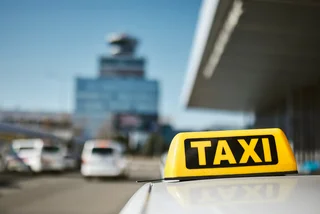The Sokol sports and physical fitness movement turns 160 years old on Feb. 16. In its prime, in the early 20th century its members could fill Strahov Stadium, at the time the world’s largest, for synchronized exercises.
Several buildings will light up in the Sokol colors of red and white on the evening of Feb. 16. In Prague, those include the Žižkov Television Tower, Tyršův dům, Petřín Lookout Tower, and the Dancing House. Sites in Ostrava, Liberec, Zlín, Uherské Hradiště, Jihlava and Přerov will also participate.
PARTNER ARTICLE
While there's a lot of fanfare associated with the movement Sokol isn't just about flashy synchronized gymnastics. For many Czechs, the organization is an important part of their national heritage, which promotes the idea of "a strong mind in a sound body." It still exists in some 1,000 villages across the country today where families and community members come together for sports and cultural activities.
Sokol began while the Czech lands were still a part of the Austro-Hungarian Empire, though historians suggest the movement has its roots in ancient Greece and similar German fitness societies. It became closely associated with Czech independence.
Founder Miroslav Tyrš first began organizing Czech physical fitness groups in 1861; the association was originally called Tělocvičná jednota pražská (Gym Exercise Union Prague). The name "sokol" which means "falcon" in Czech wasn't used until 1870.
Sokol's founding statutes were approved on Feb. 16, 1862, in Panská Street in Prague. There were 75 original members. Jindřich Fügner was elected mayor, as the leader was called, and Tyrš was deputy mayor, though he later would lead the group.
Sokol's lectures, discussions, and group outings provided Czechs with what Tyrš viewed as physical, moral, and intellectual training. This training extended to men of all ages and classes, and eventually to women. The movement also spread across a number Slavic countries.
Sokol members were active in World War I in the Czech Legions, which fought on the side of the Allies against the Austro-Hungarian Empire. Sokol’s heyday was in the First Republic of Czechoslovakia.
Czechoslovak President Tomáš Garrigue Masaryk once said, “There would have been no Legions without Sokol; there would be no Czechoslovakia without the Legions.”

Construction began on Strahov Stadium in 1926 to provide a home for mass Sokol gatherings that showcased synchronized gymnastics. The meetings were held every six years. The largest such meeting in July 1938, took place just before the start of World War II. It was attended by 348,086 Sokol members and over 2.3 million spectators.
By 1930, it had 630,000 members. Sokol members became the backbone of national teams for the Olympics. They also were instrumental in other areas of politics and public life. The movement also expanded to Slovakia, Poland, Croatia, and other countries.

Nazi Germany occupied Bohemia starting in 1939, and Sokol members were active in the resistance. On the night of Oct. 7–8, 1941, about 1,500 Sokol members were arrested including most of the top leadership, and the movement was dissolved. Most of those who had been arrested were sent to the concentration camp at Terezín, and many were later sent to Auschwitz.
Many more members were arrested on separate occasions and either executed or sent to camps. Others died in the fighting, including the Prague Uprising.
The movement never fully recovered after the war. A rally was held in June 1948, but it would be the last until after the Velvet Revolution. Another effort to restart Sokol in Czechoslovakia took place during the Prague Spring but was quickly ended when by the 1968 Soviet-led invasion.
The socialists had their own fitness movements. Strahov Stadium was renovated and would now host Spartakiads, social meetings to show off synchronized gymnastics. They were held every five years.
Other meetings have been held since then, including one in 2000 with 25,000 members. The most recent was in 2018, with 13,000 Sokol members including ones from abroad gathering in Prague.
The organization finally began to be restored in 1989, when former members met in secret to plan a new rally. One was held starting on Jan. 7, 1990, at Prague’s Výstaviště in Holešovice with 3,000 attendees, a far cry from the hundreds of thousands that attended in the interwar period.

Sokol still exists, though its membership is now much smaller. The organization currently has over 152,000 members worldwide. Normally there are 6,000 new members per year, but that goal was not achieved in 2021 due to Covid. Another issue currently facing Sokol is the rise in energy prices, as the buildings are expensive to operate.
“The financing of our association has long been unsystematic and dramatically underestimated in comparison with other sports associations. At the same time, the situation with the rise in energy prices is really critical,” said current Sokol mayor Hana Moučková who is the first woman to have held the position.
In honor of its 160th anniversary, the organization has teamed up with street artist Michal Škapa to create a new visual for Sokol. It combines the falcon symbol with a stylized background featuring Da Vinci's Vitruvian Man in a circle.
The drawing is available in a limited edition of 160 signed graphic sheets sold in the Sokol e-shop. In the spring, the design will be painted on the wall of the Sokol headquarters at Tyršův dům in Prague 1 and be visible from Újezd.
"We proudly celebrate with new ideas and respect for our ancestors, but we look to the future with apprehension," said Moučková of the 160th anniversary.
For those who are interested in participating in Sokol, the organization has an interactive map that lets you find a Sokol center near you.












 Reading time: 4 minutes
Reading time: 4 minutes 






























